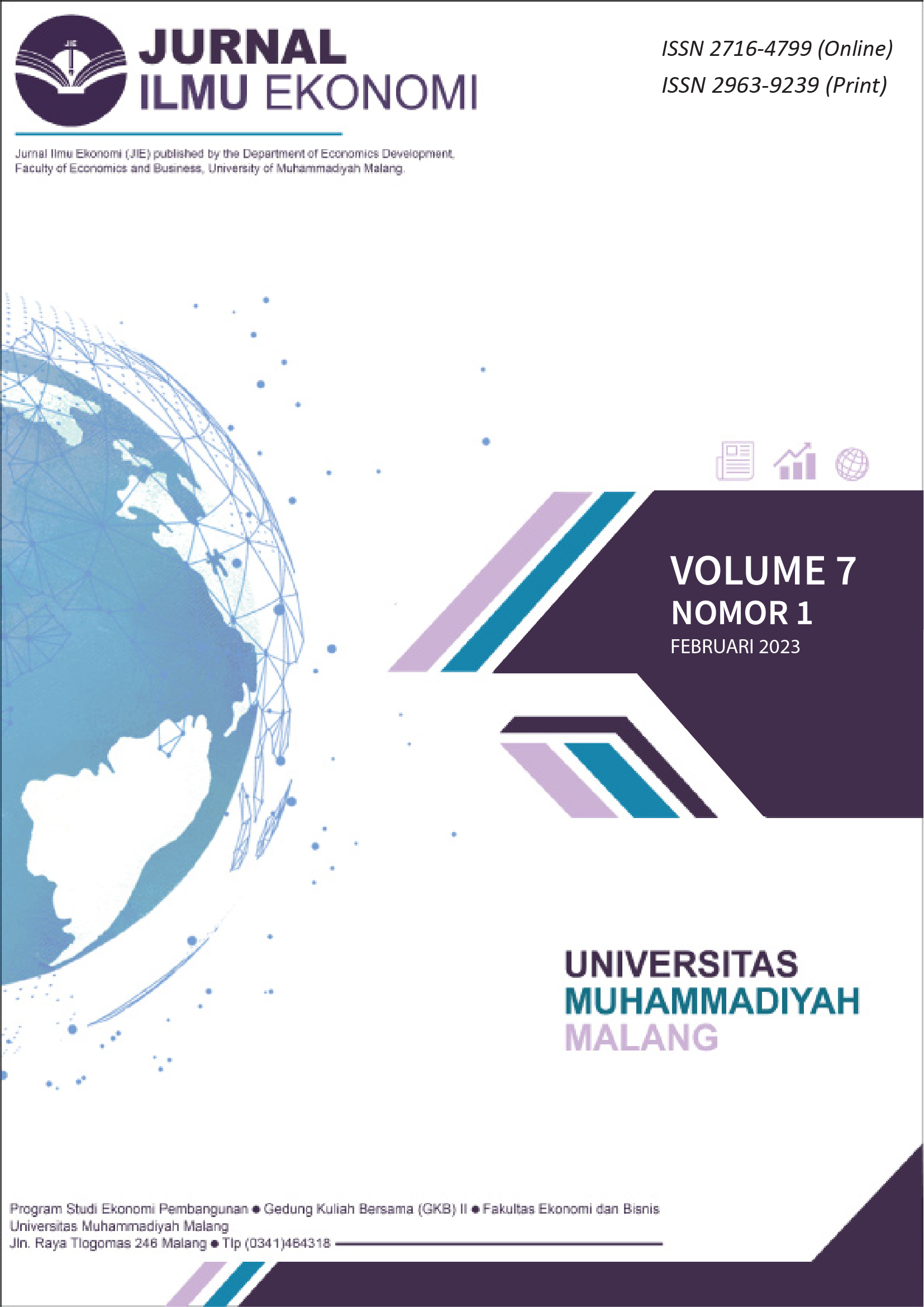Analisis Regresi Data Panel Produk Domestik Regional Bruto, Tingkat Pengangguran Terbuka, Dan Indeks Pembangunan Manusia Provinsi Bali Tahun 2012 - 2021
DOI:
https://doi.org/10.22219/jie.v7i01.22627Keywords:
Poverty, Human Development Index, Gross Regional Domestic Poduct, Open Unempoyment RateAbstract
This study aims to determine how the influence of the value of the Gross Regional Domestic Product, the Open Unemployment Rate, and the human development index on poverty in Bali Province. The purpose of this study was to determine the effect of Gross Regional Domestic Product, Open Unemployment Rate, and human development index on poverty in Bali Province for the period 2012-2021. The method used in this study is panel data regression analysis. The results of the study conclude that unemployment rate, product domestic regional bruto, and the human development index simultaneously and partially have a negative and significant effect on the poverty. The variables of product domestic regional bruto, unemployment rate, and human development index simultaneously have an influence on the poverty level in the Regency/City of Bali province.
Penelitian ini bertujuan untuk mengetahui bagaimana pengaruh nilai Produk Domestik Regional Bruto, Tingkat Pengangguran Terbuka, dan Indeks Pembangunan Manusia terhadap kemiskinan di Provinsi Bali. Tujuan dari penelitian ini adalah untuk mengetahui pengaruh Produk Domestik Regional Bruto, Tingkat Pengangguran Terbuka, dan Indeks Pembangunan Manusia di Provinsi Bali periode 2012 - 2021. Metode yang digunakan dalam penelitian ini adalah analisis regresi data panel. Hasil penelitian menyimpulkan bahwa profuk domestic regional bruto, tingkat pengangguran terbuka, dan indeks pembangunan manusia secara simultan dan parsial berpengaruh negative dan signifikan terhadap kemiskinan. Variable PDRB, TPT, dan IPM secara simultan berpengaruh terhadap tingkat kemiskinan di Kabupaten/Kota Provinsi Bali.
Downloads
References
Alhudhori, M. (2017). Pengaruh Ipm, Pdrb Dan Jumlah Pengangguran Terhadap Penduduk Miskin Di Provinsi Jambi. EKONOMIS : Journal of Economics and Business, 1(1), 113. https://doi.org/10.33087/ekonomis.v1i1.12
Andhykha, R., Handayani, H. R., & Woyanti, N. (2018). Analisis Pengaruh PDRB, Tingkat Pengangguran, dan IPM Terhadap Tingkat Kemiskinan di Provinsi Jawa Tengah. Media Ekonomi Dan Manajemen, 33(2), 113–123. https://doi.org/10.24856/mem.v33i2.671
Badan Pusat Statistik. (2022). Kesejahteraan Umum. https://www.bps.go.id/
Cholili, F. M. (2014). Analisa Pengaruh Pengangguran, Produk Domestik Regional Bruto (PDRB), dan Indeks Pembangunan Manusia (IPM) Terhadap Jumlah Penduduk Miskin (Studi Kasus 33 Provinsi di Indonesia). Jurnal Ekonomi. Jurnal Ilmiah Mahasiswa FEB, 5(5), 557–577.
Elviera, C. D., & Irawan, D. (2020). Pengaruh Indeks Pembangunan Manusia Dan Produk Domestik Bruto (Pdrb) Terhadap Kemiskinan Provinsi Sumatera Utara. Bisnis-Net Jurnal Ekonomi Dan Bisnis, 3(2), 103–109. https://doi.org/10.46576/bn.v3i2.1000
Hasibuan, R. R. A., Kartika, A., Suwito, F. A., & Agustin, L. (2022). Pengaruh Produk Domestik Regional Bruto (PDRB) terhadap Tingkat Kemiskinan Kota Medan. Reslaj : Religion Education Social Laa Roiba Journal, 4(3), 683–693. https://doi.org/10.47467/reslaj.v4i3.887
Hidayat, A. (n.d.). Penjelasan Metode Analisis Regresi Data Panel. https://www.statistikian.com/2014/11/regresi-data-panel.html
Mulyadi S. (2003). Ekonomi Sumber Daya Manusia dalam Perspektif Pembangunan (2nd ed.). PT. Raja Grafindo Persada.
Nugroho, K. A., Kristiyanto, A., & Doewes, M. (2018). Implementasi pendidikan jasmani dalam international primary curriculum. Jurnal Keolahragaan, 6(2), 110–119. https://doi.org/10.21831/jk.v0i0.21336
Prasetyoningrum, A. K. (2018). Analisis Pengaruh Indeks Pembangunan Manusia (Ipm), Pertumbuhan Ekonomi, Dan Pengangguran Terhadap Kemiskinan Di Indonesia. Equilibrium: Jurnal Ekonomi Syariah, 6(2), 217. https://doi.org/10.21043/equilibrium.v6i2.3663
Ridhoni, A. (2015). Pengaruh PDRB, Pengangguran, dan Upah Minimum terhadap Tingkat Kemiskinan Kabupaten/Kota di Provinsi Lampuang Tahun 201302015. Ekp, 13(3), 1576–1580.
Sukirno, S. (2006). Pengantar Bisnis. PT. Perdana Media grup.
Suripto, & Subayil, L. (2020). Pengaruh Tingkat Pendidikan, Pengangguran, Pertumbuhan Ekonomi dan Indeks Pembangunan Manusia terhadap Kemiskinan di Yogyakarta PEriode 2010-2017. Jurnal Ilmiah Ekonomi Pembangunan, 1(2), 127.
Yacoub, Y. (2012). Pengaruh Tingkat Pengangguran terhadap Tingkat Kemiskinan Kabupaten / Kota di Provinsi Kalimantan Barat. Eksos, 8(3), 176–185.
Yayan Wigawati, E. (2018). Analisis PEngaruh Produk Domestik Regional Bruto, Pendidikan, dan Pengangguran terhadap Kemiskinan Kabupaten/Kota Jawa Tengah Tahun 2011-2015. 6–7.
Downloads
Published
How to Cite
Issue
Section
License
Copyright (c) 2023 Alfina, W. R. A.

This work is licensed under a Creative Commons Attribution-NonCommercial-ShareAlike 4.0 International License.
Authors who publish with this journal agree to the following terms:
- For all articles published in the JIE (Jurnal Ilmu Ekonomi), copyright is retained by the authors. Authors give permission to the publisher to announce the work with conditions. When the manuscript is accepted for publication, the authors agree to the automatic transfer of non-exclusive publishing rights to the publisher.
- Authors retain copyright and grant the journal right of first publication with the work simultaneously licensed under a Creative Commons Attribution-NonCommercial-ShareAlike 4.0 International License that allows others to share the work with an acknowledgement of the work's authorship and initial publication in this journal.
- Authors are able to enter into separate, additional contractual arrangements for the non-exclusive distribution of the journal's published version of the work (e.g., post it to an institutional repository or publish it in a book), with an acknowledgement of its initial publication in this journal.
- Authors are permitted and encouraged to post their work online (e.g., in institutional repositories or on their website) prior to and during the submission process, as it can lead to productive exchanges, as well as earlier and greater citation of published work (See The Effect of Open Access).
This is an open access article and licensed under a Creative Commons Attribution-NonCommercial-ShareAlike 4.0 International License








